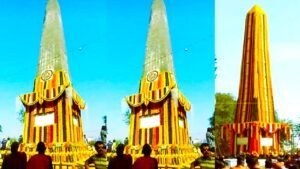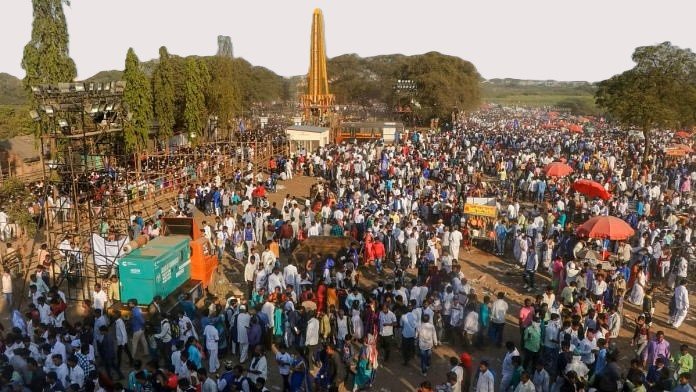Historical Background of the Battle
On 1 January 1818, Peswa was defeated at The Bhima Koregaon by the Peshwa’s 2800 army and only 500-strong army of the East India Company.
The Battle of Bhima Koregaon, 01/01/1818, stands as a defining moment in Indian history that briefs the complex socio-political dynamics of its time. The dispute occurred amid the decline of the Peswa Empire and the rising influence of the British East India Company, which looked to amplify its regional control over India. An important fit marked this period, as the Company capitalized on the internal fight within the Peswa confederacy, Basically leading to a series of conflicts that would convert the trajectory of the subcontinent’s history.
A crucial aspect of this battle was the recruitment practices pursued by the British. The East India Company often enlisted soldiers from various socio-economic backgrounds, including lower castes and Dalits, who found an opportunity for upward mobility within the military ranks. This recruitment strategy was not merely a means to bolster their forces but also a reflection of the existing caste hierarchy and societal divisions. As a result, many Dalits joined the Company’s army, motivated by the promise of land, income, and a semblance of prestige within a rigid caste system.
The climax of these socio-economic and political tensions unfolded at Bhima Koregaon, where a small contingent of Company soldiers, mostly comprised of Dalit soldiers, faced a larger Peswa force. The subsequent victory of the British forces had profound implications. It not only fortified British control but also catalyzed a gradual yet important shift in the perception of Dalits within society. The battle symbolized courage against prevailing injustices and has since evolved into a rallying point for Dalit identity and pride, reflecting broader narratives of resistance against oppression and social discrimination prevalent in India at the time.
The Battle of Bhima Koregaon: Key Events

The Battle of Bhima Koregaon, which took place on January 1, 1818, was an important encounter during the Peswa wars, boosting the strategic importance of the village of Bhima Koregaon. Located on the banks of the Bhima River, this location was central for controlling access routes in the region. The British East India Company aimed to merge its control over western India, which was faced with a formidable Peswa army aimed at challenging their authority. As tensions escalated, the forces were drawn into a dispute that would have lasting implications.
The British forces primarily consisted of the 2nd Battalion of the Bombay Native Infantry, which notably included a large number of Dalit soldiers. This battalion, despite being numerically inferior, demonstrated exceptional courage and discipline. The Peswa forces were significantly larger, estimated at around 28,000 soldiers, compared to the British’s 800 troops. However, the Dalit soldiers of the Bombay Native Infantry exhibited remarkable valor in the face of adversity, leveraging their strategic positioning and combat skills to withstand the assault. The battle unfolded with intense skirmishes as the Peswas attempted to overwhelm the British lines, yet the disciplined response of the British troops turned the tide.
Following a fierce struggle, the British forces emerged victorious, a surprising outcome given the odds stacked against them. The implications of this battle were profound; it bolstered the British hold over Maharashtra and marked an important moment for the Dalit soldiers involved. Their success in the battle became a source of pride and inspiration among Dalit communities, emphasizing their capability and role in shaping historical narratives. The aftermath of the battle also underscored the ongoing struggle between different social classes and played a crucial role in the evolving consciousness of Dalit identity in India. It reverberated through history, fostering a sense of empowerment among those who had long been marginalized.
Cultural Significance of the Battle Among Dalit Communities
The Battle of Bhima Koregaon fought on January 1, 1818, has emerged as a central symbol of pride and resistance among Dalit communities in India. This historical event, which saw a mostly lower-caste army force arrive against the Peswa Empire, has been reinterpreted over the years as a wild assertion against systemic caste discrimination. The commemoration of this battle has evolved into a major socio-political event that rolls strongly with the extant struggles of Dalits for equality and justice.
Every year, thousands gather at the Bhima Koregaon memorial, transforming it into a vibrant site of collective identity and solidarity. This annual gathering not only marks a remembrance of the battle’s historical significance but also serves as a platform for expressing Dalit aspirations and complaints. Activists, scholars, and leaders often express the significance of the battle in their speeches, remaking its role as a turning point in the ongoing struggle against caste regret. The narrative surrounding the battle thus becomes a source of empowerment, inspiring lissome community engagement and activism.
The cultural memories tied to the Battle of Bhima Koregaon also play a crucial role in shaping contemporary Dalit identity. In various forms of literature, music, and art, the battle is depicted not merely as a historical event but as a vivid symbol of courage and resistance against injustices. Dalit leaders frequently reference this battle to highlight the need for ongoing social reform, emphasizing that the fight against caste-based inequality continues to be a pressing issue. Through the lens of history, the battle offers a context for understanding the present dynamics of caste relations in India and reinforces the enduring importance of solidarity among marginalized communities.
Modern Relevance and Contemporary Commemorations
The Battle of Bhima Koregaon, fought on (01/01/1818), has surpassed its historical context to attain important modern relevance, particularly as a symbol in the ongoing struggle for equality among Dalit communities in India. The battle is remembered as a central moment where the British East India Company’s army, including many Dalit soldiers, defeated the Peshwa’s forces. This victory is interpreted by Dalit activists as a triumph over oppression and a beacon of hope for social justice.
In recent years, the battle has been increasingly referenced in various socio-political movements aimed at addressing caste inequality, a persistent issue in contemporary Indian society. Activists and scholars often invoke it to highlight the systemic discrimination faced by Dalits and to advocate for policies promoting equality. Mobilizations surrounding the Bhima Koregaon site have grown, with numerous groups advocating for Dalit rights organizing commemorative events each January 1st, thereby transforming the site into a symbol of both remembrance and resistance.
These contemporary commemorations have witnessed important participation from various societal segments, including students, intellectuals, and political leaders aligned with Dalit empowerment. The emergence of digital activism has also played a vital role in enhancing awareness and engagement, with social media platforms facilitating conversations surrounding the historical and present-day implications of the battle. Hashtags and online campaigns serve to inform a broader audience about the nuances of caste politics and the continuing relevance of Bhima Koregaon in discussions of social justice.
Ultimately, though, the legacy of Bhima Koregaon persists, symbolizing the relentless pursuit of equality and an enduring reminder of the historical struggles that continue to resonate within the Dalit community and beyond. Its commemorations today are not merely celebrations of past victories but are, in essence, an ongoing battle for rights and dignity within the broader societal consciousness.
Also Read: How to calculate your taxes
